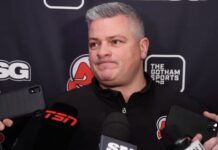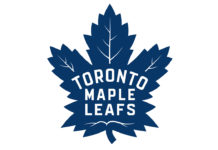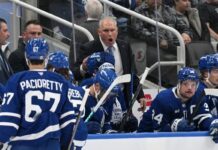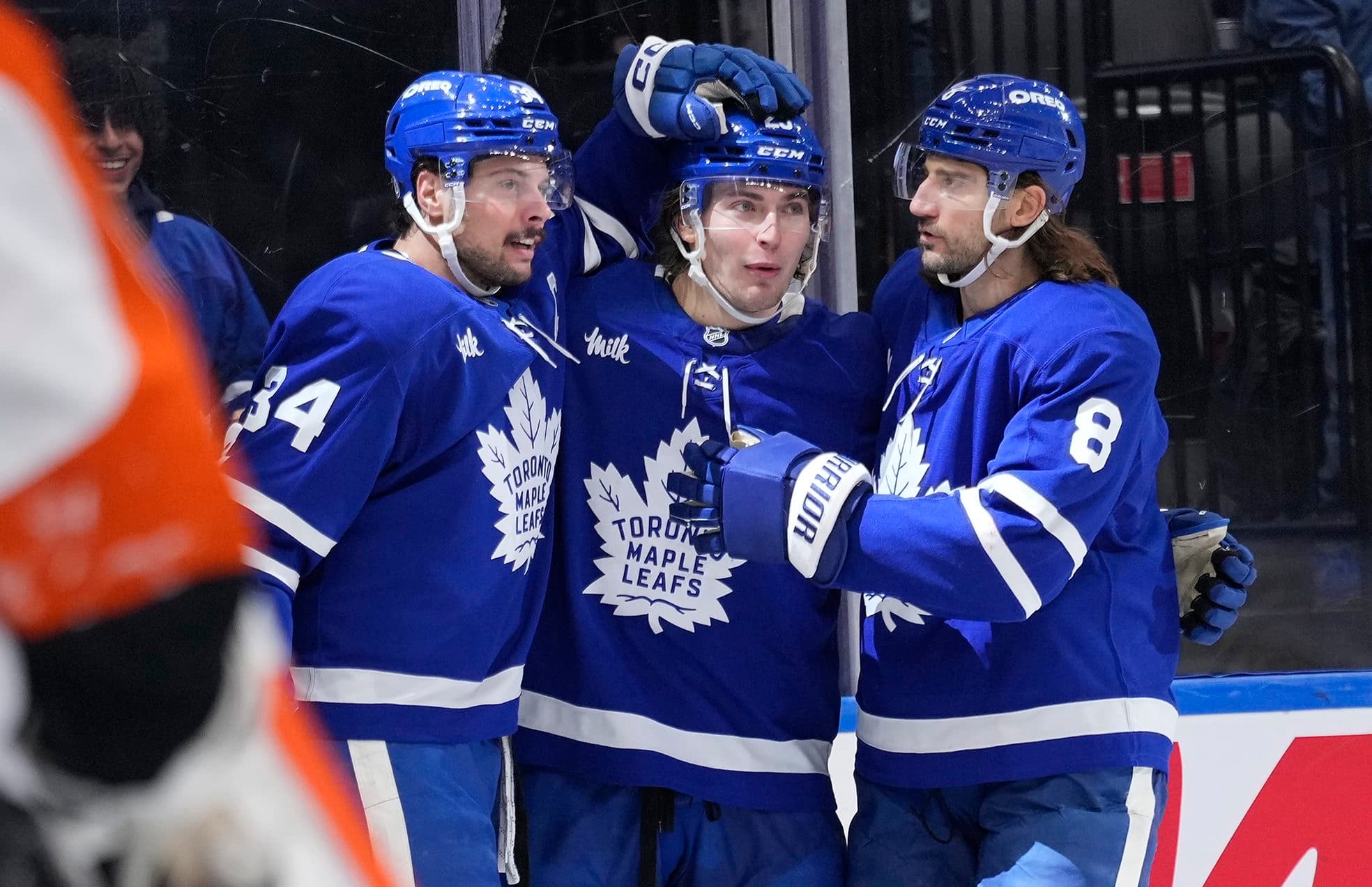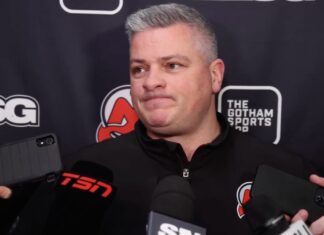Ahead of last week’s game against the Vancouver Canucks, Max Pacioretty held an insightful media availability in which he touched on several topics surrounding the Maple Leafs’ current season.
One of Pacioretty’s quotes stood out when discussing the quality of the team’s recent play:
Pacioretty: “As a team, we would like to be playing better. Obviously, there were a lot of wins in there, but we weren’t too thrilled about the process every night when it came to those wins. That doesn’t mean that you sit here and nitpick.
“I know we just went on a little bit of a heater there in terms of the standings, but we do think that we have a lot in our game to get better at, and that’s where the focus is first and foremost.”
A few days later, before the Leafs lost to the Stars, Chris Tanev was asked about beating them in the first game of the season series in Dallas:
Tanev: “They probably should have beat us, but our goalie was really good. It was a good game in Dallas, but definitely, in the first half of the game, they sort of controlled a lot of the play.”
I don’t think the veterans who have been around the block many times are fooled by the team’s calibre of performance as of late. The Leafs are getting results and are at the top of the division standings, but there is some genuine concern about the brand of hockey on display and whether it will eventually catch up to the team.
This trend has been percolating under the hood for a while now. Over a month ago, I wrote a piece arguing that the Leafs needed to get their five-on-five game in order.
If a team is spending more time in its own end than the offensive end, it will eventually catch up to them. This has become more evident as the Leafs have faced stiffer competition recently.
Cup-calibre teams command the five-on-five play
Look at the past five Cup winners for further evidence of the importance of controlling the game at five-on-five:
Generally speaking, Cup winners finish in the top 10 in control over the five-on-five shot attempts. If we look at the two lowest numbers in the top 10, note that Nikita Kucherov didn’t play a single game that season for Tampa Bay in 2020-21, while Colorado battled a slew of injuries during their Cup season. The Avalanche finished first in five-on-five Corsi the season prior, and they dominated possession when they were healthy in the playoffs during their Cup run.
Vegas is the only real outlier, although it is noteworthy that Mark Stone missed half the regular season, and Shea Theodore played only 53 games (two of their best players). It’s not impossible to play this way and achieve playoff success, but you’ll need a hot goalie to get you through it, as the Golden Knights had. Not to mention, Vegas averaged four goals per game during their Cup run compared to a Leafs team that has perennially been unable to score in the playoffs.
Ideally, a team with serious Cup aspirations tips the scales in its favour by controlling the run of five-on-five play on a regular basis.
The Maple Leafs’ performances vs. top competition
The Leafs are a good team with talent at every position, including in net, and it gets them out of a lot of “trouble,” so to speak. They can overpower bottom feeders in any number of ways.
To their credit, they’ve mostly cleaned up the glaring errors defensively, and when they play inferior teams, it’s pretty clear that as long as they don’t shoot themselves in the foot, their talent will likely find a way to win out and collect enough points for them in the standings.
James Mirtle recently looked at the Leafs’ struggles to control possession at five-on-five and provided his thoughts on why they can generally keep winning this way. One thing he noted as working in their favour is their talent to overcome the issues:
“On the season, the Leafs are shooting 9.3 percent at even strength, which is 10th in the NHL and barely above average. With their talent level, when healthy, they should easily be able to maintain (or exceed) that.”
As Mirtle also notes, the Leafs do a solid job of controlling scoring chances on both ends. Plenty of talent plus controlling the high-danger areas is a good recipe for success.
However, when sizing up the potential of a deep playoff run, they will need to start trending up in their five-on-five play, as evidenced by their recent struggles against top teams.
Washington is 2-0-1 against the Leafs, with the one Leafs win coming from a big comeback after they were thoroughly dominated in the first half of the game. They haven’t beaten Carolina in years now. Florida beat them, albeit with a mediocre Leafs roster due to injury. Wins against Boston, given the Bruins’ struggles, aren’t nearly as impressive right now, but the Leafs do seem to have Tampa Bay’s number.
The Leafs are 2-0-0 against the Devils, but suggesting they were dominated in one of those games would understate it. They are 1-1-0 against Dallas, and in their one win, they probably deserved to lose if not for Joseph Woll, as Chris Tanev noted.
Goalies are part of the team — they are allowed to win the team games — but by and large, if we go through the matchups against the top teams, the process has been poor, and occasionally, their pure talent has been enough to overcome it.
The Leafs’ two most impressive wins of the season against top competition came against Vegas and Edmonton, who they beat in successive games. They owned just 40 percent of the shot attempts at five-on-five in both games.
Are the Leafs talented enough to win like this on any given night? Sure. Does anyone really believe they will win four best-of-seven series if they play elite teams and are tilted to the tune of 60/40 shot attempts at five-on-five — especially with the Leafs’ power play?
The reasons for optimism about five-on-five improvement
So, what is happening with the Leafs at five-on-five? Why are they struggling to control play, and are there any reasons for optimism?
Let’s try to answer the last question first. I believe there’s reason for optimism beyond the fact that they are in first place in their division halfway through the season. The main reason is their talent at the top of the lineup.
Auston Matthews has not only missed a third of the season but has played injured for most of his time in the lineup, impacting his play. Even still, the difference between Matthews in the lineup compared to when he is out of the lineup is stark. In the games without Matthews, the team controlled 46.36 percent of the shot attempts at five-on-five. With Matthews in the lineup, they control 49.49 percent — still not great, but better.
That probably seems like only a few percentage points — splitting hairs, so to speak — but the gap is enormous in the league-wide context. The numbers without Matthews would place them 29th in the league in shot attempt share. With Matthews, it places them 17th. They go from lottery-level to middle of the pack, and that’s with Matthews playing through injury a lot of the time.
The gap in five-on-five control is roughly the difference of a few more shifts in the offensive zone per game, which adds up over 82 games. The more even the game, the more likely the Leafs’ talent will win out.
The domino effect of an elite 1C in the lineup vs. not is clearly massive. With Matthews in, we can see the lines come together quite logically, and those lines have generally been good at five-on-five this season.
Three of the four lines are winning the territorial battle in various roles/minutes played, and all four have won their minutes in terms of actual goals.
The Leafs just haven’t been particularly healthy this season, and the lineup has felt really out of whack due to the sheer number of injuries. The latest week-to-week injury to John Tavares is yet another setback, but if they can ever find relative health down the stretch, we can see the potential to get everyone rolling inside a set of lines that work off each other on a shift-by-shift basis. Even when healthy, it will take some time, as before the Tavares injury, it was not an overnight flip of the switch.
The five-on-five play of the top line
A few other things of note stand out about the Leafs’ numbers.
First and foremost, the Leafs are playing their top left winger (Matthew Knies), center (Auston Matthews), and right winger (Mitch Marner) together, but the line is only up two in five-on-five goals. It’s simply not good enough relative to their talent level — not even close.
Last season, this trio outscored the opposition 24-12 in over 400 minutes together. They’ve already given up more goals than all of last season in way less time together (I refreshed the page four times before writing this out to ensure my eyes were working properly).
The line is controlling play at a good clip, and it will positively impact their overall possession numbers when they start ahead of the curve in most matchups. But the bar has to be much higher, and the top line must set the tone.
The second-line options
This brings us to the second line, which is probably worthy of its own article.
Simply put, William Nylander is slumping big-time right now. It’s one thing not to produce, but now bad habits are seeping into his game as he has been burned several times blowing the zone early or forcing passes cross-ice on breakouts (Berube gave him an earful for one against Dallas in the last game, then proceeded to hand him more ice time than anyone else on the team). He’s fighting the puck in general.
34-year-old John Tavares and 35-year-old Max Pacioretty are really going nowhere in a second-line role if Nylander is not driving the bus. This is the other part of the problem, as Pacioretty, in particular, has experienced the ebbs and flows that one would expect from a veteran in his situation. When Pacioretty has been good, the line has been excellent, including some dominant games.
The team does have another second-line left-wing option in Bobby McMann, who is younger, fresher, faster, better defensively, and a simply better option for this line. In 40 minutes with Tavares-Nylander, the trio has owned over 57 percent of the shot attempts. If we add in their time together last season (115 five-on-five minutes), the line has owned around 54 percent of the attempts and outscored opponents 8-3.
McMann is fast enough to keep up with Nylander and complements Nylander’s game quite well; he doesn’t need or want the puck on his stick that much. McMann has the pace to play with Nylander, shoots a ton, is capable of burying the chances Nylander facilitates, and helps cover defensively.
However, the downside of McMann on the second line is that the third line falls apart if we flip McMann and Pacioretty. It’s somewhat of a case of robbing Peter to pay Paul.
Tavares is a much better player than Pacioretty, but before the injury, he was showing some signs of slowing down as the season has progressed. This is the exact time in the schedule when Tavares hit a career-worst goal drought last season. The Four-Nations break will serve him well, but even if we stretch out the sample, the Tavares-Nylander combination has not scored more goals than they’ve given up in three straight seasons (they are up 17-9 so far this season, but it is trending down now).
The bottom six
This brings us to the third line, which started hot but has since cooled off. They generally do a good job of creating offense, even if they aren’t burying right now (Max Domi hasn’t scored in 12 straight, and Nick Robertson has one goal in his last eight).
Therein lies the rub. This is a sheltered offensive line with the talent to create good looks offensively, and they will push the puck up the ice and are a dangerous rush threat. However, if they aren’t scoring goals, there is little utility. They aren’t good enough defensively to take on tough matchups and open the game up for the lines above them. They have to score to take some pressure off the top lines.
It’s an admittedly small sample size, so I don’t think we should spill too much ink on the fourth line, but the pieces are in place. All three players are legitimately good defensive checkers and offer additional value on the penalty kill. They can be trusted to take defensive-zone faceoffs and check against top lines, swinging some of the other matchups further up the lineup.
The trio needs time together, and a good next step for them, beyond the defensive utility, is creating more energy and swinging momentum with a big forechecking or hustle shift. They won’t score much, but they can bring other things to the table to positively impact games in a limited fourth-line role. The logic behind the line combination is sound, at the very least.
There is room for optimism with this Leafs team’s five-on-five potential, knowing the lines are in place to dictate play. We can also see why there is so much talk about adding a center. A quality 3C would, in theory, allow them to move McMann up to the second line and Domi to the wing, to say nothing of the benefits of upgrading the talent on the roster in general.
A bigger addition than a 3C would allow them to play around with many scenarios: flipping Nylander up with Matthews and moving Marner next to the new C; playing the new C with Nylander and McMann while Tavares anchors a third line with Domi and Pacioretty; moving Domi up with Matthews to spread out Matthews, Marner, and Nylander across three lines, and so on.
The state of the Maple Leafs’ defense
Of course, it is not only about the forwards. As much as we have focused on the forward group, a large part of the Leafs’ struggles territorially have been due to failures to break out cleanly.
Games are adding up where all of Simon Benoit, Philippe Myers, and Conor Timmins are dressing, and two of them are off-the-glass type of defensemen. Timmins is skilled and effective with time and space but struggles with aggressive forechecks.
The team’s top pairing of Jake McCabe and Chris Tanev is so effective partly because they are really good at moving the puck up the ice cleanly. They make clean tape-to-tape passes to advance the puck on a regular basis.
When we look at the pairing’s raw possession numbers, they might not stand out as impressive, but they are getting buried in tough matchups and coming out ahead. They control the slot defensively and help drive offense up the ice.
The biggest issues lie with the rest of the defense group. The Leafs’ defense doesn’t exactly take advantage of working around a McCabe-Tanev pairing.
The “offensive” pairing, the one on the ice for the most offensive-zone shifts, has been okay at controlling play and has shown some signs of hope as Myers has settled into the lineup, but they are ultimately not producing and have been outscored.
When they tried a similar pairing dynamic with Rielly – OEL (over 65% offensive zone starts), the duo also got outscored and spent a bunch of time in their own end. They should have been feasting but instead were feasted on.
This leads to the makeshift third pairing of Benoit and OEL, whose results are generally more of the same. They certainly don’t tilt the ice, and the best thing we can say about them to this point is that they have sawed off their goals for and against.
The Leafs have two pairings that don’t look particularly good on paper or in reality. How will they beat elite teams in the playoffs with two pairings leaving much to be desired?
How the defense is ultimately sorted out is anyone’s guess. Would splitting up McCabe and Tanev be worth it for the greater good? Would a Jani Hakanpaa return change anything? Does adding a defenseman to play with Rielly — potentially pushing Myers down to play with OEL in the process — solve it? You can make all those arguments, but the reality is that the defense, in its current configuration, leaves a lot to be desired.
The Maple Leafs’ style-of-play shift under Craig Berube
Finally, looking beyond the personnel and lineup configuration, there seems to be some systemic disconnect.
Defensively, the opposition is working the points against the Leafs with regularity. Toronto’s wingers routinely collapse well below the top of the circles, leaving the points wide open for the opponent to work pucks low-to-high and tee off. Almost every top team will happily take those looks, and it has led to far too many sequences where teams are shooting, grabbing rebounds, and cycling, with the Leafs unable to break it.
After the Carolina game, Berube said, “We need to kill more plays and come up with more pucks. We didn’t. It kind of got away from us.” The Leafs collapse and protect the house well, but they need to do a better job engaging the puck carrier to disrupt the offense and turn the play the other way.
Offensively, there are a few systemic issues to flag as well. Controlling play territorially requires a cohesive plan with the puck to continuously retain it and generate offense. To this point, the team’s offensive approach has felt disjointed, and the five-on-five results have been inconsistent as a result.
The Leafs have tried to shift to more of a forecheck and crash-the-net offense, and I’m not sure the buy-in is there to this point. They struggled to score early on in the season and started snapping out of it late, as they’ve gotten healthy (pre-Tavares injury) and opened it up more off the rush.
The offense from the point is nearly nonexistent. As Alec noted last week after the Leafs’ loss to Carolina, the Hurricanes (at the time) had over 300 more shot attempts from their top six defensemen compared to the Leafs’ this season. The Hurricanes are machine-like in how they work the points and crash the net, while the Leafs spend a lot of time on the perimeter and generate very little from their defense/crashing the net offensively.
Berube has spent a lot of time in his media availabilities this season talking about the need for the team — and some of the individual players — to shoot more. The coach clearly wants his team to funnel more pucks to the net with traffic and grind for offense in the scoring areas, but the team has not even come close to doing it on a regular basis. They have been shut out three times this season after going almost three years without a clean sheet against, and it’s not a case of the bounces catching up to them. There have been far too many games where they have looked completely listless on offense.
Is it a case of only playing half a season adjusting under a new system, a half-season riddled with injuries? Or is it a bit of a square peg/round hole situation whereby the players have been asked to play a style of game they are either unable or unwilling to play?
Luckily, the team is in a good spot in the standings to survive a rough patch and maybe even take a small step back in order to take two steps forward regarding their process and style of play. It’s a natural process in an 82-game season, and there’s no reason to sound the alarm bells just yet.
However, the warning signs have been there for quite some time now. There are a few reasons for genuine optimism, especially if the team could ever stay healthy, but as we said last month, the Leafs need to start putting their game together consistently at five-on-five.


